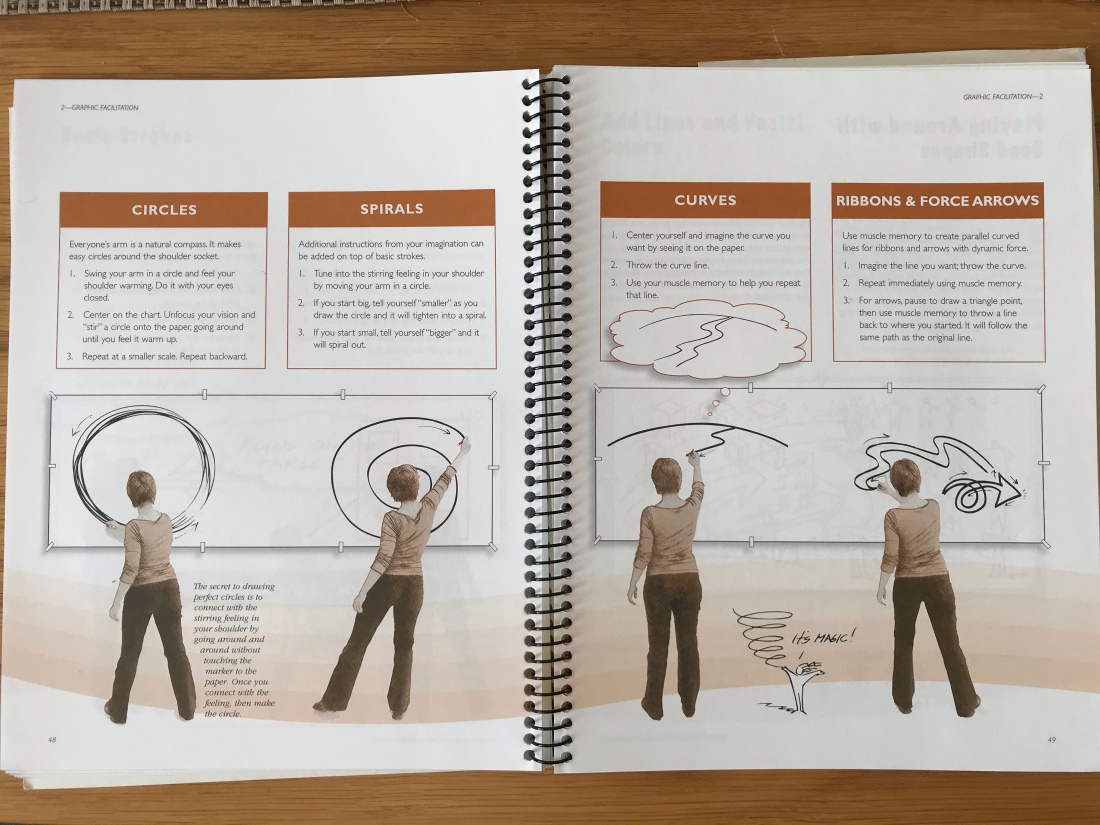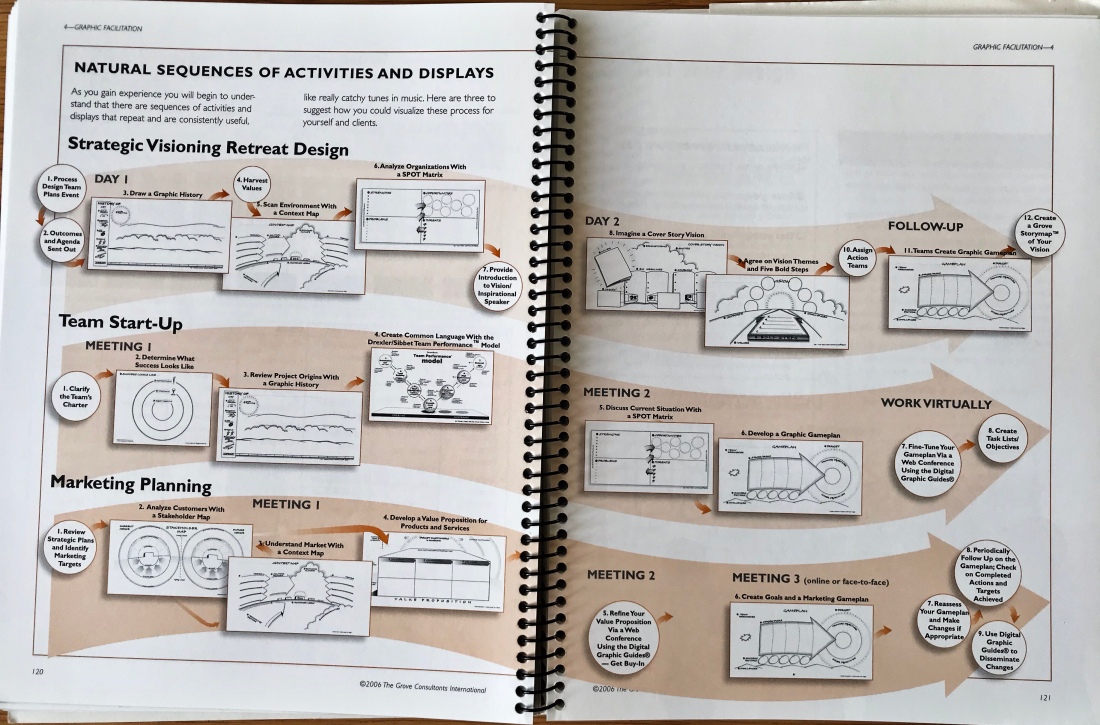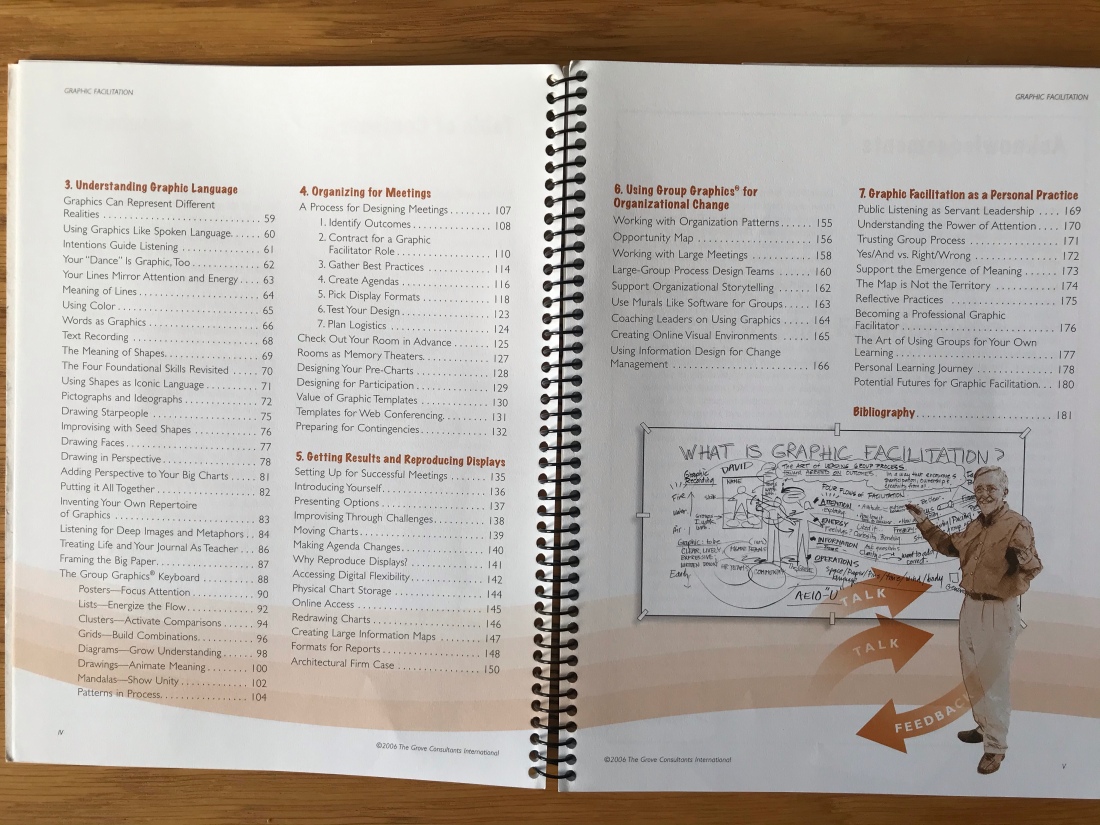
I am not a big fan of New Year’s resolutions, but I have set myself a challenge for 2020. Whilst it sounds pretty easy, I am not so sure that it will be. I have committed to not buying any more books or purchasing / attending any courses. I have a huge backlog of books to read and online courses / resources that I have purchased but not necessarily completed. A couple of courses I also want to complete a second time.
Whilst I am not going to be reviewing every book I read, I thought it would be interesting to review some of them, particularly those around visual thinking / graphic facilitation. This is the first review.
I chose this book as the first, as it was the first book on graphic facilitation that I purchased when I started to take an interest in this facet of facilitation. At that time it was the only book I could find dedicated to the field.
The book examines the role and work of graphic facilitators who “scribe” or record meetings live and also those that create and use pre-prepared large scale visual templates. My work is mainly on the large visual template side of things.
Even though this was published in 2006, I still think this is a solid introduction. As you can see below from the photographs of the index, the book covers a whole range of subjects. Having never worked with Grove style templates or large visuals, this was a great starter on how to use and create them. The book comes with a DVD in which David Sibbet outlines a lot of the core ideas of the book. I need to go and hunt through my old DVD collection, as I have removed the one that comes from the book.
The book is very practical, and as you would expect for a book about working visually, is dense in imagery throughout its 180 or so pages:


A few more images from inside the book can be found HERE on David’s book launch blog. (I am purposefully only including two pages from inside the book, beyond cover and contents, in order to protect the IP of the author).
Overall I think this book would be good for people keen to add visual skills to their work (trainers, coaches and facilitators) or for recorders looking to become more like facilitators. It is jam packed full of tips, trick and ideas for planning, running and following up on meetings, events and conferences using visuals.
This is a solid book that covers a wide range of areas although I think there are better books out there for some specific areas, like “structuring” live recording work, such as Brandy Agerbeck’s “The Idea shapers”. In the case of lettering my author of choice for this would be Heather Martinez. See HERE for links to their work. Some of David’s more recent books cover similar ground and expand on it, but this book is in my opinion a “must buy” if you are getting into the facilitation end of visuals using templates.
Some of the main take aways for me are:
1) The section that looks at professional development – basically a series of codified tips on improving your practice. This covers 42 ways that you can improve your visual practice. Some nice ideas to consider.
2) The basics of charting, from handling / pinning / moving large format paper on walls through to using the body to draw. I must admit I had forgotten the paper handling part, so this has been very helpful.
3) The group graphics keyboard that organises chart types into a structured typology. This section is very comprehensive and gives a solid range of examples for each type.

4) I really enjoyed the final section around professional practice. This explores how we can deepen our work as practitioners.
5) The section on improvising through challenges such as falling behind when recording or not being sure where to position new ideas on a visual.
6) The section on role definition and contracting was a great reminder on how to approach this and had some good tips.
Four issues I see with the book:
1) It is not readily available in major book sellers. It can be found HERE on The Grove online store.
2) Price. At the time of writing this is 70$, and whilst I don’t think this is particularly expensive for a professional book, the postage direct from The Grove adds a fair chunk to this. This will be a bigger barrier for international shipping.
3) It does not really consider in depth the role of digital graphical work, which has really come to the fore in the decade since the book was written.
4) Not available electronically – I would love to see this and all books available in a digital medium and I have been unable to find a digital version of this book. David’s more recent books are available digitally.
Contents of the book:


Similar books, that I have in my collection are David Sibbet’s Visual Meetings or Visual Consulting and separately the Visual Collaboration by Ole Qvist-Sorensen, and Loa Baastrup is also a good book on “template” based facilitation. The GameStorming book by Grey, Brown & Macanufo has a range of the Grove Visual templates but does not cover facilitation in depth.
Overall I think this was a good investment of money and time, and I have certainly enjoyed revisiting it.
Technical Specs: Spiral bound and just slightly larger than A4 – Back cover folds out to provide a 2 page spread of the graphic keyboard. Paper weight seems to be around 100gm. Due to spiral binding it is not particularly sturdy and too much use could wear it out / break the cover off – I certainly feel it is pretty flimsy. ISBN is 1-879502-57-7 and it has 184 pages. Bibliography has just over 50 books mentioned. There is no index.
This was my first review of a book and so I would like to thanks Heather Martinez for ideas around content, Mark Monlux for suggesting including the technical specifications and Paula Fagerberg & Chitra Chandrashekhar for their feedback over on the MeWe Graphic Facilitation site. I will be writing reviews on the others books I have. You can find more resources around visual books HERE.
Please note: All images here are intended to allow the readers of this blog to better understand the content and style of the book. I am not the copyright holder and the content is the Intellectual Property of David Sibbet.
Is this helpful? What else would you like to know in future book reviews?

What are your thoughts on this....